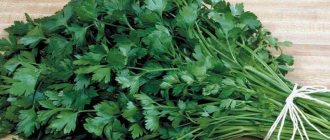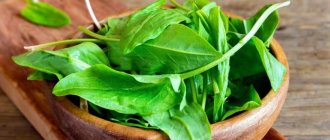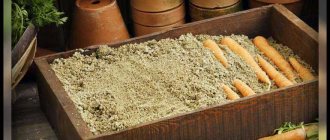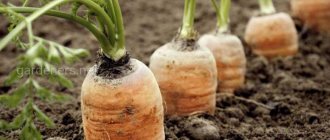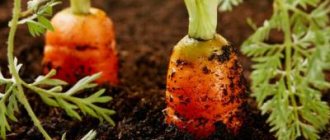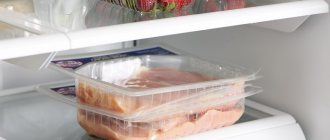During the harvest season, many housewives wonder whether it is possible to freeze carrots for the winter and whether they will retain their taste and beneficial properties. Of course, freezing is one of the easiest and fastest ways to prepare, allowing you to save the bulk of the vitamins and microelements contained in root vegetables.
The ability to store vegetables frozen is especially important if you do not have a cellar or basement.
How long do frozen carrots last?
In 90% of cases, gardeners choose a cellar or underground as a storage location. A refrigerator is a necessary measure that is considered last if there is no basement or garage. However, freezing is no worse than a cellar. With its help, the set of nutrients will remain the same. Besides, you don’t have to go into the dungeon for the next portion. Just open the freezer door, remove the product and throw it into a saucepan with aromatic borscht.
Freezing carrots for the winter in the freezer is easy if you know how to do it. But the refrigerator is unsuitable for these purposes. A red vegetable can remain in it without signs of spoilage for no more than 2-3 weeks: the temperature is unsuitable, from zero and above. Read more about the features of storing carrots in the refrigerator in our article.
If you plan to store frozen carrots for a maximum of three months, you need to set the temperature on the regulator to about 7-9 degrees with a minus sign. If the goal is to freeze carrots for twice as long, you need to set the freezer temperature to 12 degrees cold or lower.
At the lowest possible temperature values from -20 °C and below, carrots can last even a year. But after defrosting, it is important to use such carrots within a short period of time.
Shelf life
How long frozen orange root vegetables will retain their quality depends on the container and freezer. It is best to store carrots in an insulated freezer with a deep freeze function. This chamber guarantees the freshness of vegetables throughout the whole year. In a regular freezer, carrots can be stored for 7-9 months. It is recommended to keep it in a closed container to protect it from foreign odors.
Interesting! The California town of Holtville hosts a week-long Carrot Festival every February. During the week, participants choose a "carrot queen", hold a carrot parade, cook the best dishes using the orange root vegetable, and also participate in sports competitions using carrots as equipment.
The ideal storage temperature for frozen carrots is -18...-23°C. At this temperature, bacteria and pests die and natural wilting slows down.
The benefits and harms of frozen carrots
It is incredibly beneficial for vision. But in addition to carotenes, it contains many other vitamins. Dozens of minerals are present. If frozen correctly, up to 80-90% of valuable elements are preserved. Even storing carrots in a cellar or a cold pit at a temperature of +1 degree does not guarantee this.
Useful properties of frozen carrots:
- increases immunity;
- strengthens teeth;
- contains antioxidants;
- improves the functioning of the nervous system;
- improves vision;
- source of important substances;
- cleanses the kidneys;
- strengthens the heart muscle;
- has a positive effect on blood composition.
How do you freeze carrots?
Raw Boiled
The product will cause harm if you have a duodenal ulcer. It should not be consumed raw in case of gastrointestinal diseases in the acute stage or inflammatory processes in the small intestine. Another contraindication is hemorrhoids.
Carrots can be frozen whole, grated, or pureed for the winter. Prepare raw, fried, boiled vegetables. Shelf life 9-12 months.
What are the benefits of carrots?
Photo: envato.com
Finally, it is worth mentioning the nutritional value of carrots. The nutrients in its composition are better absorbed by the body when carrots are consumed cooked rather than raw. The exception is carrot juice.
Carrots contain falcarinol (a natural pesticide) and beta-carotene, which destroys tumor-causing free radicals and prevents early aging.
It's good to know that 1 cup of chopped raw carrots contains 52 calories, 12 grams of carbohydrates, 6 grams of sugar, 4 grams of fiber and 410 mg of potassium.
other methods
If you don't have any freezer space, you can choose one of the following methods.
In salt
Despite the popularity of freezing, pickling parsley for the winter still remains a favorite method among thrifty housewives. Salt is an excellent preservative, allowing greens to remain fresh for a long time. This method is easy to implement at home:
- Carefully sort and rinse the grass, then pat it dry with a towel to remove excess moisture.
- Finely chop the parsley or grind it in a blender and mix the preparation with non-iodized table salt at the rate of 1 tbsp. l. salt per 200-300 g of leaves.
- When a sufficient amount of juice has been released, stir the mass again until the salt is completely dissolved and place it in sterilized jars.
Store the mixture in a cool place under a tin or thick nylon lid. In this form, parsley can be stored for about 1 year.
In oil
Another preservative that will help keep parsley fresh for the winter is sunflower oil. Prepare the greens as described in the previous options, then chop and place in clean, dry jars.
Pour the contents with refined oil and mix the mixture thoroughly so that the liquid is evenly distributed throughout the entire volume of greens. The top of the parsley should be completely covered with oil. Store sealed containers in a cool place for up to 6 months.
In brine
Instead of vegetable oil, you can use brine or marinade as a filling. This method will allow you to preserve the product for more than 12 months. Place the chopped greens in jars and fill with hot brine prepared from 1 liter of water from 30 g of salt, then sterilize for 5 minutes and roll up the lids.
To prepare the marinade, use the following ingredients:
- 1 liter of water;
- 50 g sugar;
- 50 g salt;
- 200 ml 6% vinegar.
Drying
In order to preserve parsley for the winter, you can use a time-tested method - drying. Typically, such greens are added to hot dishes to add flavor.
Tear off the leaves from clean stems and spread them in a thin layer on a regular kitchen towel. Leave the workpiece to dry in the fresh air or in a well-ventilated area and stir occasionally.
If you want to make a concentrated spice, grind the dry leaves in a coffee grinder. To add flavor and aroma to the dish, a pinch of this seasoning will be enough.
Dry leaves should be stored away from pungent odors and dampness.
You can dry parsley along with the stems by finely cutting the bunches with a knife or scissors. The crushed workpiece is dried as described above, or an oven is used to speed up the process.
Line a baking sheet with baking parchment and lay out the chopped herbs or leaves in an even thin layer. It will take about 2 hours to dry completely. Dry the parsley at a temperature of no more than +40 ℃ for about an hour and a half, then increase it to +70 ℃ and leave the greens for another 20-30 minutes.
Store the product in hermetically sealed glass or ceramic jars in a dark place for up to 2 years. Fabric bags with drawstrings are also suitable for long-term storage of dried herbs.
We hope that our recommendations will help you prepare parsley for the winter in order to preserve vitamins and taste to the maximum.
Preparing carrots for freezing
To freeze carrots without losing their valuable properties and taste, leaving them juicy and aromatic, you need to follow some recommendations.
- We choose ripe, dense and whole fruits, not spoiled by bugs or fungus, without signs of incipient decomposition. It is better to give preference to cone-shaped samples - they contain more vitamins.
- Carrots, among other things, should not have grooves, chips and cracks, which tend to form during an excessively rainy season. In the future, moisture from the carrots will seep through the cracks, turning into unnecessary additional ice.
Small carrots can be frozen whole and then used to make broths and jellied meats, where whole vegetables are preferable.
- It is forbidden to store very old fruits, as well as loose and too hard ones, in the freezer.
- Freezing root vegetables for the winter at home involves first wiping off adhering clods of earth and dust, thoroughly rinsing them in running water, and removing a thin layer of peel and white tails.
- Before being placed in the chamber, carrots are either cut in the preferred way - into cubes, bars, circles, pieces, or grated.
After preparation, chopped carrots should be cooked with boiling water or steam. This will provide additional guarantee that pathogenic microorganisms are completely destroyed.
How to freeze
Before you start freezing, it is recommended to decide how the thawed root vegetable will be used. The cutting method and the degree of processing of the vegetable depend on this.
Whole
Washed and peeled root vegetables are dipped in boiling water for 2-3 minutes and immediately cooled in cold water. Then they are dried and placed in prepared containers.
Chopped
It is convenient to freeze carrots in slices - circles, strips or cubes up to 6 mm. The vegetables are dried and placed in a labeled container (with the date of freezing), which is sent to the freezer.
To prevent the pieces from sticking together, the chopped carrots are first scattered on a tray and left in the freezer for 1-2 hours. Then they are transferred to a container and put back in the freezer.
Interesting! Afghanistan is considered the birthplace of carrots. It was here that she was first discovered. Back then it grew in the wild and was purple and white and yellow. Orange carrots came to Russia from the Netherlands, where they were grown for the royal family. Regular consumption of orange vegetables can change the color of a person’s skin to yellow. This property is used by zoologists to preserve the color of the plumage of brightly colored birds. In addition, carrots are added to the diet of cat breeds that have red hair.
An example of storing chopped root vegetables is in the photo.
Blanched
Is it possible to freeze boiled carrots to avoid long cooking or stewing after defrosting? Yes, to do this, the root vegetable is blanched for a few minutes before freezing to improve the taste and reduce its cooking time in the future. Then douse with cold water.
Blanching algorithm:
- Place a saucepan filled 2/3 with water on the fire.
- Sliced or whole vegetables are immersed in boiling water.
- After 2 minutes, the carrots are quickly transferred to ice water. Let the root vegetables cool for another 2 minutes.
- Place the vegetables in a colander to drain the water.
- The dried carrots are laid out in a thin layer on a board and placed in the freezer for 2-3 hours.
- Frozen vegetables are placed in containers and put back in the freezer.
Grated
Usually raw carrots are frozen by grating them. The technology of this process is simple: the vegetable is grated and placed in baking molds, after 1-2 hours, when it is completely frozen, it is transferred from the molds into bags or plastic containers.
This produces convenient portions of grated root vegetables that can be used for roasting and complex recipes. For example, the Korean pickling recipe does not exclude the use of grated thawed carrots.
Puree
Young parents and lovers of fresh carrot puree freeze the vegetable in the form of ready-made carrot pulp. To do this, boil the root vegetable in unsalted water for 20-30 minutes, and then puree it with a blender to the desired consistency. A meat grinder is also suitable for grinding carrots into puree. Future complementary foods for the baby are placed in a sterile container and sent to the freezer.
How long can frozen beets be stored?
Freezing beets is the best way to prepare them for the winter. Firstly, it is light, and secondly, freezing is faster than wrapping canned food. The third argument is that a minimum of resources is wasted: it is enough to put grated or whole beets in the freezer for the winter. And finally, root vegetables stored in this form retain maximum benefits.
And in order to ensure that the crop does not really lose its taste and vitamins, the beets should be placed in the freezer immediately after being removed from the ground. The sooner the product goes into winter storage, the better.
Now that we have found out that freezing beets for the winter is not only possible, but also necessary, it remains to find out how long they can be stored. On this score, gardeners do not have a common opinion. Some say – a maximum of four months. Others believe that nothing will happen to the vegetable in a year. And the optimal period is about six months to eight months.
How to defrost
- It is important to freeze beets for the winter at home in an extremely short time, and defrost them as slowly as possible. This way valuable substances will be preserved.
- The optimal solution is to remove the frozen products ahead of time and place them on the shelf closest to the freezer.
- Defrosting is acceptable at a temperature of 18 degrees or more, in the kitchen or room.
- It is allowed to season dishes with frozen beets without first thawing them. Especially if we are talking about chopped vegetables that were frozen raw.
- It is strictly forbidden to defrost with boiling water or in a microwave oven.
Almost any vegetable can be frozen for the winter, including beets. The root vegetable is subjected to heat treatment both raw and boiled. In order to freeze beets at home, there are several ways. Let's take a closer look at the most popular methods of preparing for the winter.
Is it possible to use a freezer?
The traditional way to store carrots is to pack them in boxes or bags, which are located in a dark and cool place, which is usually the cellar. But in a city apartment this is usually not possible, so you should give preference to freezing it (you can find out how to preserve carrots in an apartment in this article).
Storing carrots in the freezer is a great way to provide yourself with this vegetable throughout the cold season. When frozen, carrots retain a large amount of useful substances that will help avoid vitamin deficiency.
How to properly pack frozen carrots
Packaging, along with preparation and storage temperature conditions, is the third important component of successful freezing.
Packaging steps:
- The most suitable storage option is a plastic container or vacuum sealed bag. But it is better to refuse glass containers. When frozen under the influence of critically low temperatures, glass may burst. Then you will have to say goodbye to both the container and its contents;
- After the container is selected, it is important to correctly place the root crop inside. The pieces are placed so that the remaining 3-3.5 cm on top are free. The result will be an imitation of an “air cushion”;
- the container is tightly sealed and sent to the freezer.
If the housewife has chosen the option of freezing not in a container, but in a bag, then all the air is first expelled from it. Once the bag is filled with carrots, it is sealed with a clip or tape.
Useful composition of carrots
Package
Frozen carrots are stored in the following packages:
- plastic containers;
- plastic bags;
- glass containers;
- vacuum bags.
Glass has a disadvantage: there is a high probability of cracks from the cold. Polyethylene breaks quickly. Food grade plastic containers are ideal. Vacuum bags are often used to ensure complete sealing. For storage, leave a little air so that the product does not burst the bag when expanding.
Defrosting and using the product
Frozen carrots are often added to hot dishes, then thawing is not required. Defrost for baking, some snacks, salads. The correct method is to place it on the refrigerator shelf. If you need to speed up the process, fill the package with cold water. You can use a special microwave oven mode.
Options for using the workpiece:
- raw grated carrots, pieces. Used in first and second courses, casseroles, for minced meat, filling;
- boiled carrots. A ready-made ingredient for salads, sauces, and can be added to casseroles;
- fried frozen. Sautéing is added to soups, stews, gravies, and minced meat. Used for casseroles, some appetizers, salads;
- puree. In addition to baby food, it is used in cream soups, sauces, and smoothies.
Frozen vegetable mixtures with carrots are stewed, baked, and used for stuffing poultry. This is an excellent basis for light soups and national dishes. The only point is that we do not recommend adding greens right away. It's better to freeze separately.
Alternative Methods
There are other options for storing grated carrots without freezing. Let's look at them.
Drying
In a city apartment, carrots (pre-cut into thin slices or strips) are dried in the oven, microwave, on the balcony or in a special dryer. Dried root vegetables contain a large amount of useful substances . They are stored for up to a year in linen bags or containers without access to air.
We recommend watching a video of drying carrots for long-term storage:
Conservation
The vegetable can be used when preparing homemade preparations for the winter. Carrots in hot and spicy canned salads have a long shelf life.
You can also dry carrot tops . Dried tops brewed with boiling water are a healthy and tasty drink.
Suitable container
While the vegetables are drying, you can choose a container for freezing.
These could be:
- small plastic trays (containers);
- disposable cups;
- special bags designed for storing frozen products;
- molds for ice or baking (for mashed potatoes or grated carrots);
- polyethylene bags with a clasp.
You can also use ordinary plastic bags, but they must be durable and always new.
When using a plastic container, remember to leave 1-1.25 cm of empty space up to the lid, since vegetables expand when frozen and need free space.
How to properly freeze grated carrots
Freezing grated root vegetables is one of the most popular options, because it has several important advantages. Grating carrots is much faster than chopping them in the same volumes. This preparation is more compact, so it can be stored even in small freezers. Subsequently, it can be used to prepare soups, stews, pies and many other dishes.
Step by step recipe:
- Peel the pre-washed carrots and rinse in clean water. Then let it dry.
- Grind the root vegetable in a food processor using a grater (coarse or fine).
- Pack the preparations into portions and place them in the freezer.
- After an hour, stir it thoroughly. This way it will turn out crumbly and will be easier to take out.
Attention!
If during the chopping process it turns out that the carrots are very juicy, prepare something from them immediately and do not leave them for storage. Otherwise, when frozen, all the juice will come out of it, and you will get carrot ice and dry cake.
Preparing the vegetable
How to prepare carrots for freezing?
You will need some kind of sterilization , which is necessary to protect food from the development of diseases, mold, rotting, changes in taste, color and other negative consequences.
Most of the vitamins and minerals will be saved, and you will be able to enjoy the benefits of carrots during the cold season. Also, after this stage, vegetables will not fall under the harmful influence of some natural enzymes, and the smell, color and rich color will not disappear anywhere.
How to do blanching ? To do this, you will need a sufficient amount of freshly boiled and cold water, including a good supply of ice cubes (about a dozen). Cold water is useful for quickly cooling each portion.
to process carrots in separate batches: small-sized vegetables are cooked separately from large ones. As soon as the water boils, pour the carrots into the pan without reducing the heat. It will take 4-6 minutes to cook whole and large vegetables, while 2 minutes is enough for smaller and cut into pieces.
As a rule, water evaporates quickly, and you cannot do adding water After the set time has passed, all the carrots are sent to a container with ice water. It will take exactly the same amount of time to keep it there as it was cooked.
Ice water is needed so as not to cook the crop so much that it becomes unsuitable for storage in the freezer.
At the last stage of this stage, the vegetables are removed from the water and placed in a colander and then on towels to dry completely . After this, the carrots can be grated, chopped or immediately frozen.
After blanching, carrots are sometimes given another preparation, thanks to which individual roots and segments are most likely not frozen to each other . To do this, you need a wooden board on which the pieces are laid out in one layer, so that they do not touch each other.
A wire rack or baking tray will do the same job perfectly. After two to three hours, remove and scrape the product off the surface if necessary.
How to prepare carrots for storage is described here.
How to defrost carrots correctly
To properly defrost carrots, the container with the vegetable is transferred to the main chamber of the refrigerator, where it slowly moves from frozen to fresh. It’s easy to check the condition of carrots - you can pierce the thawed vegetable with a fork.
It is not recommended to place frozen carrots directly into boiling water or boiling oil in a frying pan. If you need to speed up the defrosting process, it is better to use cold water, placing a container with root vegetables in it, or a microwave oven with a defrosting function.
About the benefits
What are the benefits of frozen carrots? First of all, frozen vegetables save your wallet and time. Frozen during the warm season, fresh carrots lose a minimal amount of nutrients , including vitamins.
Even in this case, it will turn out to be much more useful than what is imported from completely different regions and countries.
This is explained by the fact that during import, carrots and other products may not be in the best environment, subject to special spraying and other treatments that are aimed at giving an artificial shine and enhancing the aroma.
Further, at any time you can defrost the required amount of carrots and use it to prepare borscht or another dish. This way you will replenish the missing supply of vitamins during the cold season without additional difficulties.
Naturally, you shouldn’t completely replace fresh foods with frozen ones in your diet if conditions allow you to eat freshly picked from the garden. Read our articles about how and when it is best to harvest carrots from the garden and how to properly prepare them for long-term storage.
Original recipes for freezing carrots for the winter
Salt freezing of carrots is also allowed, and in combination with other vegetables - beets, sweet peppers, potatoes, corn, onions, peas, zucchini. With the solo version everything is clear. It is enough to use any of the listed processing methods - blanch, puree or save whole.
Variations of assorted vegetables:
- carrots, potatoes, beets;
- carrots and onions;
- carrots, onions, peas and corn;
- carrots, onions, beets, yellow or red bell peppers.
The proportions of the composition can be any, and the vegetables themselves can be cut differently. It depends on the goals and taste preferences of the family.
The resulting mixture is added to stir-fries, soups and other first courses, as well as salads. You don’t even have to defrost it before adding it – very convenient.
Previous
Vegetables and mushroomsWhat happens if you freeze leeks?
Next
Vegetables and mushrooms Do I need to trim the tops of carrots for winter storage in the cellar?
Other reception features
Below we consider controversial situations regarding how best to prepare carrots and in what form they are most beneficial to consume.
- Carrot juice contains fewer vitamins and minerals than the pulp of the plant. It is better to eat whole raw carrots. And after preparing the juice, the pulp should definitely be thrown away.
- Carrot tops are rich in selenium, which strengthens the immune system and reduces the risk of cancer. Carrot leaves are also used in folk medicine to normalize the tone of the uterus, eliminate edema and prevent urolithiasis. However, these properties have not been scientifically proven.
- Korean carrots have a pronounced antiviral, antibacterial, antiseptic and choleretic effect. However, for people with chronic diseases of the stomach and duodenum, it is better to avoid this recipe.
- Grated apple with carrots is useful for strengthening the immune system, accelerating the healing of any wounds and reducing body weight. Carrots also go well with beets and celery.
- Carrot tea is effective in lowering blood pressure, treating prostatitis and strengthening the immune system.
- Carrot oil is usually used to normalize the emotional background (eliminate depression, stimulate mental activity). It is also used in cosmetology to increase elasticity and eliminate wrinkles on the face and other parts of the body.
- Young carrots (baby carrots) are absolutely no different from mature ones. The qualitative composition is similar.
What to do if something goes wrong?
Even if you follow the technology for freezing carrots, you may encounter difficulties. Let's look at what problems may arise and how to solve them:
- During the process of cooking vegetables (especially when grating), it turned out that they release a lot of liquid. In order not to get separately frozen carrot juice and dry cake, it is better to process such fruits in a juicer.
- If you find that the vegetables are tough and not juicy, then the best way to freeze them is to boil or blanch them. Using this technique, the situation can be easily corrected.
- If carrots have become saturated with the smell of other foods in the refrigerator, then you need to seal the bags and containers in which they are packaged. Or place bags of rice grains in the refrigerator - they will absorb all foreign odors.
Freezing secrets
You need to freeze in small portions, it’s convenient and you don’t need to defrost the excess amount. It is better to thaw food in the refrigerator. Because there is too much temperature difference in the room or in the microwave, which destroys vitamins. You can eat such products, but they still have few beneficial properties.
Correct action: in the evening, take out everything you need for tomorrow from the freezer and put it on a special shelf in the refrigerator. Repeated freezing is extremely undesirable, and in some cases dangerous to health.
Additional Tips and Warnings
Here are some additional tips. When freezing carrots for the winter, it is recommended to follow certain rules :
In order for carrots to be tasty in a dish after defrosting, you need to choose the right variety: moderately juicy, well-structured.- When peeling the fruits, carefully monitor whether the root crop is rotten inside. Such carrots can cause poisoning.
- If the root crop seems to smell musty, it is better not to freeze it.
- Don't skip the drying phase of chopped vegetables: use paper or cloth towels for this.
- The faster the freezing process takes place, the more vitamins in vegetables can be preserved. First, you need to set the temperature in the freezer to -35°C, and after the fruits are frozen, reduce it to the optimal setting.
- Don't forget about alternative methods for storing carrots at home.
Carrots stored in the freezer will delight the housewife with everything: the ability to use winter preparations at any time in cooking, their taste, ease of processing, and savings. Don't ignore this great method for storing root vegetables. And the result will exceed all expectations!
If you find an error, please select a piece of text and press Ctrl+Enter.
Important information
Many people wonder whether it is possible to freeze carrots and whether the beneficial substances are retained in them? If you follow all the rules, then all the vitamins will be preserved, and the grated product can be easily added to any dish without wasting time.
Reasons why many housewives prefer to store vegetables in the freezer.
- Saving money. In winter, vegetables are much more expensive; it is much more pleasant to take an already prepared product from the refrigerator without leaving home.
- It is unknown under what conditions the product is stored in store conditions. In addition, winter vegetables on the shelves often undergo additional processing for better storage and flavor. Therefore, when you take your carrots out of the freezer, you can be sure that they are environmentally friendly.
- Save time. When starting to cook, you don’t need to waste time peeling and chopping vegetables. Is everything ready!
- It happens that there is nowhere to store vegetables from your garden. In this case, the freezer comes to the rescue. Not everyone has spacious cellars and basements (in addition, in these rooms it is also necessary to maintain the correct conditions).
A small root vegetable with a dense structure and a sweetish taste is suitable for freezing. Carrots can be stored either whole or chopped.
It is not necessary to buy a freezer for storage; many refrigerators have a freezer, in which any vegetables, including carrots, should be stored for a long time. Transfer to a regular refrigerator compartment only when gradual defrosting of the product is required.



